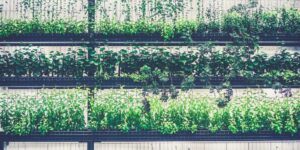
Hydroponic farming is the process of growing plants in nutrient-rich water without using soil. It is considered to be advantageous when compared with conventional farming because it simplifies the growth process, reduces labor costs, minimizes erosion, and improves crop yields. As a result, hydroponic practices are common today in commercial agriculture. Still, this method has some drawbacks: hydroponics need artificial lighting, potentially enhancing the spread of plant diseases, and may increase crop yields in regular outdoor conditions beyond what they would be.
Hydroponics takes its name from the Greek words “hydro,” which means “water,” and “ponos,” which means “labor.” It is a subset of hydroculture, defined as cultivating plants in water.
Hydroponics is sometimes called “soilless gardening,” but it differs from growing crops directly in water. In hydroponic farming, the soil is used only to anchor the plant’s roots until they can support themselves. Hydroponic farmers use various nutrient solutions containing mineral salts dissolved in water. This nutrient solution is delivered to the plant’s root system through an automated process.
The nutrients are dissolved because these crops generally have small root systems, and the supply must be diluted to be absorbed efficiently. If the roots had to grow into soil rich in clay, it would take days or weeks to spread enough to gather enough nutrition for the plant to survive. With hydroponics, nutrients can be administered in a highly-concentrated solution and immediately taken up by the root system.
Hydroponic farming also includes technology used for climate control in greenhouses: fans, dehumidifiers, and heating systems (similarly, these can be controlled by automated systems). It is commonly used in warm, moist climates because it allows crops to grow all year round. However, hydroponics presents certain disadvantages: it needs artificial lighting and ventilation and often results in greater crop yields than regular outdoor conditions.
Hydroponics is typically done in greenhouses, but it is possible to set up an indoor hydroponic farm in buildings with sufficient space for large-scale crop production. Hydroponics can be used for commercial or personal gardening purposes, although the latter is more popular among hobbyists.
Some Advantages of Hydroponic Farming
According to the experts at hydroponics supplier Progrow, some advantages of hydroponic farming include:
1) Year-Round Growing
Hydroponic systems can be set up to grow all year long. So you can get twice the harvest by growing out of season, giving you higher profits.
2) Profits by Weight Grown, Not Acreage
With hydroponics, you can produce more than double the product’s weight compared to soil-grown crops. With increased yield per square foot, you can maximize the profit potential.
3) Higher Yields with Less Work
By eliminating weeding and thinning, your labor costs are drastically reduced. Even harvesting is easier, as many hydroponic systems allow you to run a ‘cut and come again’ operation (new shoots continuously regrow from the main plant).
4) Fewer Water Needs
Growing in water conserves water compared to soil, and hydroponic systems recycle nutrients back into the water. This can also help you save money on your overall yearly operation costs.
5) Less Space Required to Start
Due to the reduced weight of soil needed for hydroponics, shipping is reduced considerably. This means you can transport your products by land or sea, to get them to market faster.
Written by Rida Sheppard
Source: TG Daily – The Advantages of Hydroponic Farming
